Within hours of the assassination of conservative activist Charlie Kirk, edited videos began to spread online. Some focused on the moment Kirk was shot — zooming in on the obviously fatal wound to make the strange claim that he hadn’t been killed at all: that the video was a fake, generated by computer, or that a squeeze of his right arm was proof he had popped a capsule to make it appear as if blood was pouring from his neck.
In videos that each racked up hundreds of thousands of views, one Illinois creator pointed to photos of the Turning Point USA founder making an “OK” sign with his hands: these symbols, they said, proved Kirk had not only had faked his death, but that it also actually revealed his alignment with a demonic cabal that secretly controlled the world.
Kirk is, of course, senselessly and indisputably dead. That fact alone was enough to shatter reality, even for people outside the gravitational pull of internet conspiracy culture.
Kirk is, of course, senselessly and indisputably dead. That fact alone was enough to shatter reality.
At 31, Kirk was arguably the most popular and influential figure in right-wing politics outside of Trump — for whom he acted as a strategist, the guy who brought young people into the MAGA movement and helped win Arizona. To the religious right, he was a hero. To many on the left, an avatar of racism, transphobia and misogyny. And to tens of thousands of young people, especially men, who packed his rallies and the millions more who watched his clips online, Kirk was someone who could talk to anyone, win any argument and offered a vision of life filled with purpose and power. He connected MAHA and MAGA and sealed Trump’s selection of JD Vance for vice president. Kirk was, as his podcast intro declared, “the voice of a generation” and, many believed, a future president.
And then he was gone. Not just gone but stolen, executed on livestream in an act so violent, so graphic, that the only other event that comes close to its trauma in memory was President John F. Kennedy’s assassination — viewed by most in grainy footage that doesn’t approach the detailed horror of Kirk’s recorded murder, seen almost instantaneously by millions.
According to the most current information from law enforcement, the shooting appears to be the work of a single suspect: 22-year-old Tyler Robinson, a bright electrician-in-training who was taken into custody 33 hours after the shooting and was formally charged in Utah on Tuesday. Utah Gov. Spencer Cox said Robinson was motivated by and “deeply indoctrinated with leftist ideology,” citing statements from family members and messages sent to friends.
Yet, almost immediately after Kirk was shot, a wave of conspiracy theories from both the right and the left rushed in to cloud that reality — to deny it outright or to twist it into something politically useful. This kind of conspiracy theorizing was inevitable — what researchers call collective sensemaking as we try to understand what we’ve just experienced. It’s a process that happens in two parts: the assembling of evidence and the framing.

These theories drew on hundreds of photos and videos captured by rallygoers, organizers, federal law enforcement and news outlets. Users dissected the videos, marking them with red circles and arrows. In one video, a man adjusting his hat was labeled a conspirator signaling a hitman. In others, Kirk was said to have been shot not from above but from behind, with the assassin identified alternately as a man tugging his sleeve or a fuzzy figure in white.
Conspiracy theories live on a spectrum of possibility and politics. Some built around the Kirk assassination are far-flung ones, pushed by flat-earthers and false-flag obsessives. Others, more mainstream, have without strong evidence pointed blame at Israel, farther-right antisemitic activists, imaginary underground progressive terrorist organizations and Donald Trump himself. Some were likely motivated by belief, but others perhaps by a desire for internet attention, for entertainment or for political purposes yet to be seen.
“Charlie Kirk’s assassination was not just some kid,” former Trump adviser Steve Bannon told his War Room listeners Monday, inviting them to watch surveillance video of the alleged shooter descending a roof, footage that has been held up as evidence by some MAGA influencers that Kash Patel’s FBI is hiding something.
“It seems like we’re being spoon-fed a narrative, and this audience is not going to take it, and we’re not going to allow the martyr Charlie Kirk to have a situation like a grassy knoll that decades and decades and decades later, we’re still arguing about this. We’ve got to get to the bottom of it.”
It is fitting, maybe, that so many conspiracy theories have engulfed Kirk upon his death. In life, Kirk entertained conspiracy theories, trafficked in them and benefited from their unchecked spread. Over the years on his podcast, Kirk leaned into conspiracy theories including the “great reset” (a globalist plot to control the world) and the “great replacement” (a Democratic plot to erase the white race). On his podcast where he fashioned himself as a Christian Rush Limbaugh, Kirk spread claims that Haitians in Springfield, Ohio, were “taking people’s pets and eating them,” that American men had been purposefully “feminized,” that the media was hiding something about the attack on Paul Pelosi, and that President Joe Biden had intentionally ignored weather disasters so they could be used to promote policies that addressed climate change. Kirk pushed debunked theories that a nebulous group of government “theys” conspired to steal elections, set up peaceful patriots to attack the Capitol on Jan. 6 and forced deadly vaccines on unwitting Americans.
At the same time, Kirk surrounded himself with conspiracy theorists — a growing influence of power within the conservative establishment.
At the same time, Kirk surrounded himself with conspiracy theorists — a growing influence of power within the conservative establishment — including President Trump, Robert F. Kennedy Jr., Candace Owens and radio host Alex Jones, to name a few.
Jones and Owens now count among the conspiracy creators focused on Kirk’s death.
“Who called the hit on Charlie?” Owens posted on X the day after the shooting.
Owens, his longtime friend and former employee, has spent the last several days publicly grieving while posting about “some very powerful billionaires” that she said Kirk was facing pressure from over his wavering support for Israel. In her online show Monday, she also suggested something nefarious about the FBI’s handling of the crime.
“If they had wanted to catch Charlie’s killer, they would have immediately publicized all pictures and videos and the internet would have solved it in minutes,” Owens posted. “The desire was never there.”
As is his custom, Jones immediately leapt on Kirk’s death. But this time, he didn’t theorize, as he had with children murdered in their elementary school, that Kirk’s death was a production of the government to rip away gun rights. Instead, he claimed this was an execution overseen and commanded by “a trans death cult.” (The suspect was in a romantic relationship with a roommate who is transgender and who is cooperating with authorities, Gov. Cox said last week. Officials have not yet suggested that Robinson was motivated by trans issues.)
“The Soros strike force has been activated,” Jones posted Monday, referring to the liberal billionaire donor.
The framing of Kirk’s death, as staged or part of a larger plot, may not hold. But a more insidious narrative — one less easily debunked or written over with facts learned during a criminal case against Robinson — is already being amplified by the Trump administration. Fueled by raw emotion and few facts, this frame is shaping into something likely to be more durable and destructive.
On a special episode of The Charlie Kirk Podcast, broadcast Monday from a wood-paneled office in the White House complex, the administration’s most senior officials joined guest host Vice President JD Vance to eulogize Kirk. Flanked by American and vice presidential flags, deputy chief of staff for policy Stephen Miller sipped tea and pointed to a shadowy alliance of progressive organizations, funders and activists who, he claimed, are ultimately responsible for Kirk’s killing. He cited this narrative as justification to unleash the power of the federal government upon its contrived threats so that, as Vance said, something like Kirk’s assassination would never happen again.
“With God as my witness, we are going to use every resource we have at the Department of Justice, Homeland Security and throughout this government to identify, disrupt, dismantle and destroy these networks and make America safe again,” Miller said, defining the unnamed networks as “the organized doxxing campaigns, the organized riots, the organized street violence, the organized campaigns of dehumanization, vilification, posting people’s addresses, combining that with messaging designed to trigger, incite violence and the actual organized cells that carry out and facilitate the violence.”
This narrative is the ultimate conspiracy theory. That its enemy is so fundamentally undefined is the source of its power. The characters in this story are so broad that it can be weaponized against any and every perceived political enemy. It already has been.
The day after Kirk was shot, anonymous self-described political operatives registered a website, “CharliesMurderers.com” which crowdsourced screenshots and identifying details to accuse people of celebrating his murder. People featured on the site — whose remarks were often misrepresented — have reported receiving death threats and being fired from their jobs. The anonymous organizers, who solicit donations, claim to have more than 60,000 submissions and plan to publish soon. Meanwhile, Cabinet secretaries and the heads of federal departments have been tasked with identifying organizations they claim fund and incite left-wing violence, according to The New York Times. Attorney General Pam Bondi claimed Monday, without evidence, that “left-wing radicals” killed Kirk, and that “they” would be held to account.
It’s a tactic Kirk would have approved of. It was Kirk who built the professor “watchlist,” intended to expose alleged leftist bias but which ultimately led to doxxing and death threats for hundreds of academics. It was Kirk who argued that the only way to heal the country’s political divisions was for conservatives to “win.” Kirk was the kind of strategist who understood when to lean into a grand conspiracy theory for the greater MAGA good.
Kirk helped cultivate a modern conservative worldview that declared itself at war with the left. In death, he has become the main character in its central conspiracy theory.

